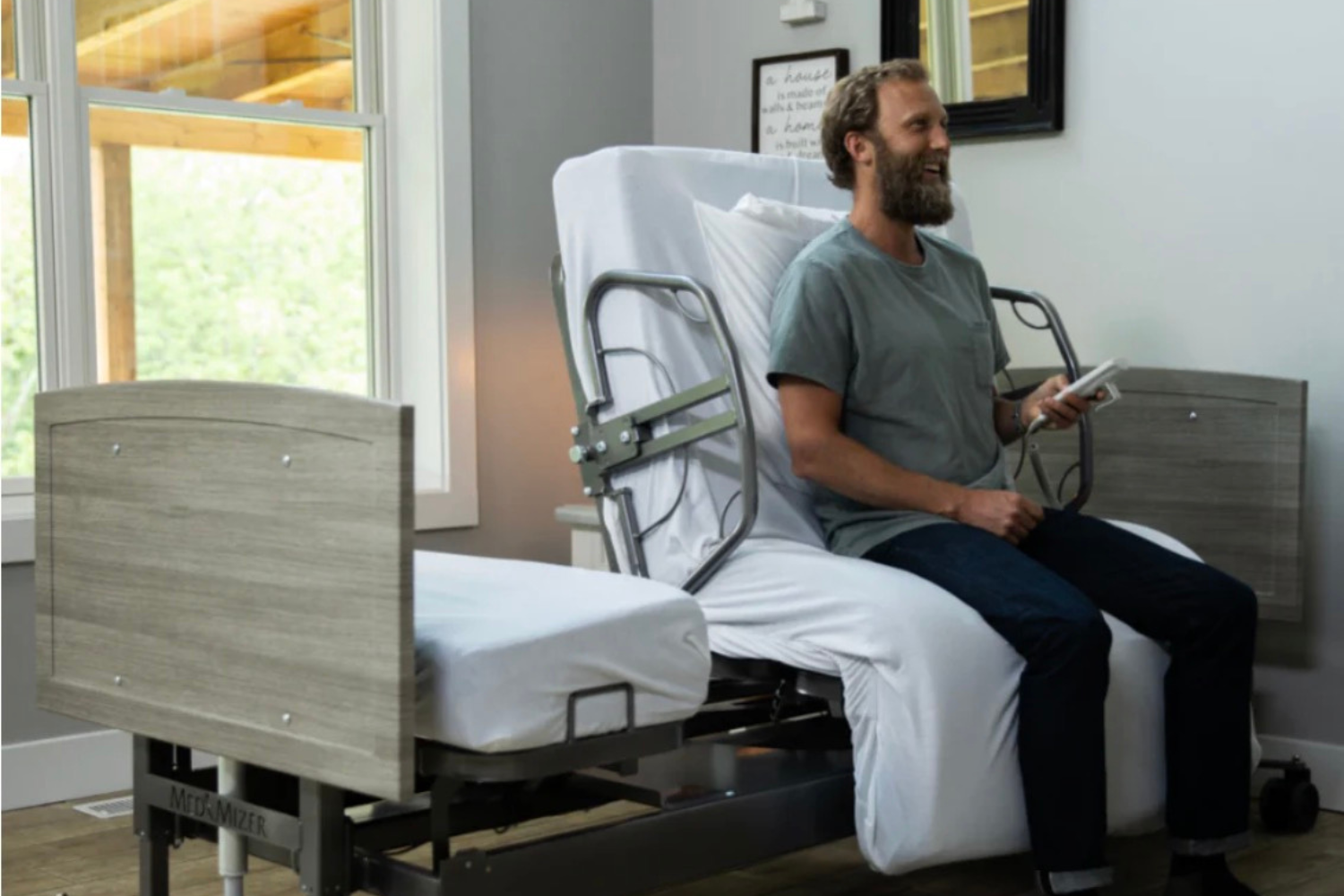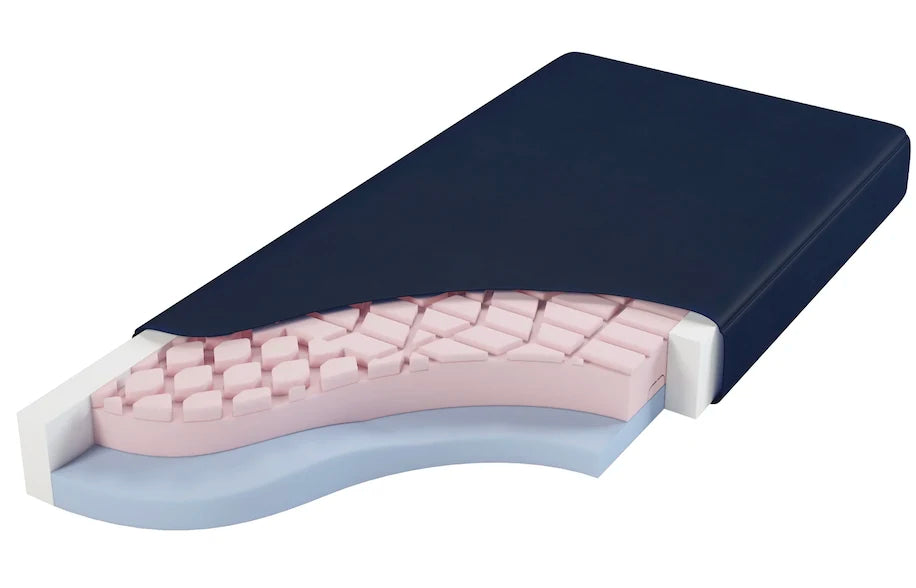Menu

Hospital Bed Buying Guide

BASICS
The Bed Frame
The bed frame makes a huge difference in the support and stability of your loved ones bed. Bed frames differ from bed decks (spring, grid, slat and full) which provide support for the mattress, features (Manual, Semi, Full Electric, Hi-Low, Trendelenburg, Bariatric...) and overall durability (weight capacity, warranty etc...) Manual and Semi Electric Beds are less costly than Full Electric Beds and are designed for loved ones that will be needing the bed for a shorter period of time. Manual and Semi Electric Beds have spring decks and a less durable frame, so if you are looking for a bed that will be used more than 16 hours a day and/or a bed that will be used for longer than 6 months, a Full Electric Bed with a grid, slat or full deck would be more appropriate. High End Beds offer more features for your loved one and provides a much more stable and supportive bed.
When deciding which bed makes sense for your loved one, consider not only the length of time the bed will be needed, but which mattress and features are needed as well. High End Beds will come with higher prevention mattresses which will provide better support and overall skin care.
Mattresses
While the bed’s functions and structure are important considerations, the mattress also plays a critical role in providing comfort and support. Mattress selection is especially critical in patients who are confined to their beds for longer than normal sleeping times, since these patients can be prone to pressure sores, or “bed” sores. Prevention Foam Mattresses, Low Air Loss Mattresses, Lateral Rotation Mattresses and other products can help relieve pressure and prevent skin breakdown that eventually causes sores to develop.
Hi-Low Beds
Frequently Asked Questions
When you are deciding which hospital bed would be best for your loved one, there are specific questions you need to think about to make sure you can make a proper comparison among products:
- How many hours a day will your loved one be in bed?
- How long will the bed be needed for?
- Is your loved one at risk of falling out of bed?
- What frame would provide the best support and stability for your loved one?
- Looking to the future are there any additional needs that your loved one will have?
- Will you need to have the bed set up?
Important considerations include how long your loved one will be using the bed and mattress, how mobile they are, whether they're at an increased risk of falling, how much care they'll need while in the bed, and who will be providing that care.
Remember: Both the bed and the mattress play important roles in maintaining comfort for your loved one, so be sure to consider all aspects of care when making a selection.
TYPES OF BEDS
Full-Electric Beds
Full-electric beds use the same type of remote control as a semi-electric bed, but the remote controls the height of the entire bed as well as foot and head adjustments. Full-electric beds use a pulley system with steel cables to safely adjust the height for patients who need the bed to be lowered so they can easily get up, and for caregivers who prefer the bed to be higher for care activities or to change linens.
Benefits:
- Adjustment of all features is fully electric, requiring no physical strength
- Good choice for patients who leave the bed from time to time
Disadvantage:
- Higher cost than manual or semi-electric beds
Hi-Low Beds
A hi-low bed can be an excellent choice for a patient at an increased risk for falling out of bed. Offering the same features as a full-electric bed, hi-low beds feature a bed deck that’s only 7 inches from the floor. Even with the addition of a 6-inch mattress, fall height would be restricted to 13 inches. Adding a fall mat reduces the risk of injury as well as the fall height. Hi-low beds also rise automatically as the patient is standing to provide extra support and assistance.
Benefits:
- Low profile increases patient safety and minimizes fall risks
- Auto-rise feature reduces physical stress on patients and caregivers
Disadvantage:
- Slightly higher cost than full-electric beds
Heavy Duty (Bariatric) Beds
Bariatric hospital beds feature strong, durable frames designed to support patients from 350 lbs. to 1000 lbs. Frames are also wider than standard beds to provide greater patient comfort while offering the same functions as a full-electric bed for convenience and ease of use.
Benefit:
- Durable, wider frame designed specifically for heavier patients
Disadvantage:
- Higher cost than a standard electric bed
Section
Drop element here
Long Term Hospital Beds
Long Term Hospital Beds are designed to fully support and care for your loved one or patient for years. These beds are great solutions for those who need proper support and preventative care. Long Term Beds have either grid, slat or solid bed decks that will fully support the mattress and person in bed.
Benefits:
- Great for long term needs.
- Grid, Slat and Solid decks will provide optimal support and comfort for the user.
- Bed deck provides 100% support of the user.
- Deck will maintain it's integrity for as long as you have the bed.
- Solid and durable construction that will last for years.
Disadvantage:
- Little higher price due to upgraded motors and more substantial frame.

TYPES OF MATTRESSES
Foam Prevention Mattresses
Foam Prevention Mattresses are ideal for patients who spend long periods of time lying in bed including patients who are immobile. Unlike basic foam or innerspring mattresses that can increase pressure and heat on specific areas of the body, causing skin breakdown and bed sore development, prevention mattresses are designed to prevent sores from developing while still providing plenty of comfort.
Benefits:
- Helps prevent development of painful pressure and heat bed sores
- Provides an economical prevention strategy
Disadvantage:
- Not a good choice for patients who already have bed sores
Alternating Pressure Mattresses
For patients who have ulcers or have a history of ulcer development, an alternating pressure mattress offers both pressure relief and skin moisture management by altering the inflation and deflation of individual air cells. These mattresses offer relief of pressure points and promote blood flow and circulation for healthier skin and better healing.
Benefits:
- Ideal for ulcer therapy
- Altering cell inflation manages pressure pointsImproves circulation for better healing
Disadvantage:
- Less expensive models offer fewer air bladders/less therapeutic support
Low Air-Loss Mattresses
For patients who have ulcers or have a history of ulcer development, an alternating pressure mattress offers both pressure relief and skin moisture management by altering the inflation and deflation of individual air cells. These mattresses offer relief of pressure points and promote blood flow and circulation for healthier skin and better healing.
Benefit:
- Provides ideal pressure and moisture balance for better healing of skin ulcers and healthy skin overall
Disadvantage:
- Blower noise may be bothersome to some patients
Alternating Pressure Mattresses
For patients who have ulcers or have a history of ulcer development, an alternating pressure mattress offers both pressure relief and skin moisture management by altering the inflation and deflation of individual air cells. These mattresses offer relief of pressure points and promote blood flow and circulation for healthier skin and better healing.
Benefits:
- Ideal for ulcer therapy
- Altering cell inflation manages pressure pointsImproves circulation for better healing
Disadvantage:
- Less expensive models offer fewer air bladders/less therapeutic support
Heavy-Duty (Bariatric) Mattresses
Bariatric mattresses are available in both foam and air-circulating styles designed with the extra support necessary to provide consistent comfort for patients from 350 lbs. to 1000 lbs.
- Benefit:
Best choice or bariatric patients
- Disadvantage:
Foam options may feel too firm for some patients
Alternating Pressure Mattresses
For patients who have ulcers or have a history of ulcer development, an alternating pressure mattress offers both pressure relief and skin moisture management by altering the inflation and deflation of individual air cells. These mattresses offer relief of pressure points and promote blood flow and circulation for healthier skin and better healing.
Benefits:
- Ideal for ulcer therapy
- Altering cell inflation manages pressure pointsImproves circulation for better healing
Disadvantage:
- Less expensive models offer fewer air bladders/less therapeutic support
Lateral Rotation Mattresses
Like the low air-loss mattress, lateral rotation mattresses are ideal for patients who need ulcer therapy. These mattresses gently rotate the patient from side to side to relieve pressure points, and offer the added benefits of promoting digestion and circulation and reducing the risk of pulmonary complications. A blower provides constant air flow to help balance skin moisture for better healing.
- Benefit:
Best choice for those who are unable to turnProvides ideal pressure and moisture balance for better healing of skin ulcers and healthy skin overall
Offers benefits for digestion, circulation and lung health
- Disadvantage:
Blower noise may be bothersome to some patients
- Choosing a selection results in a full page refresh.

